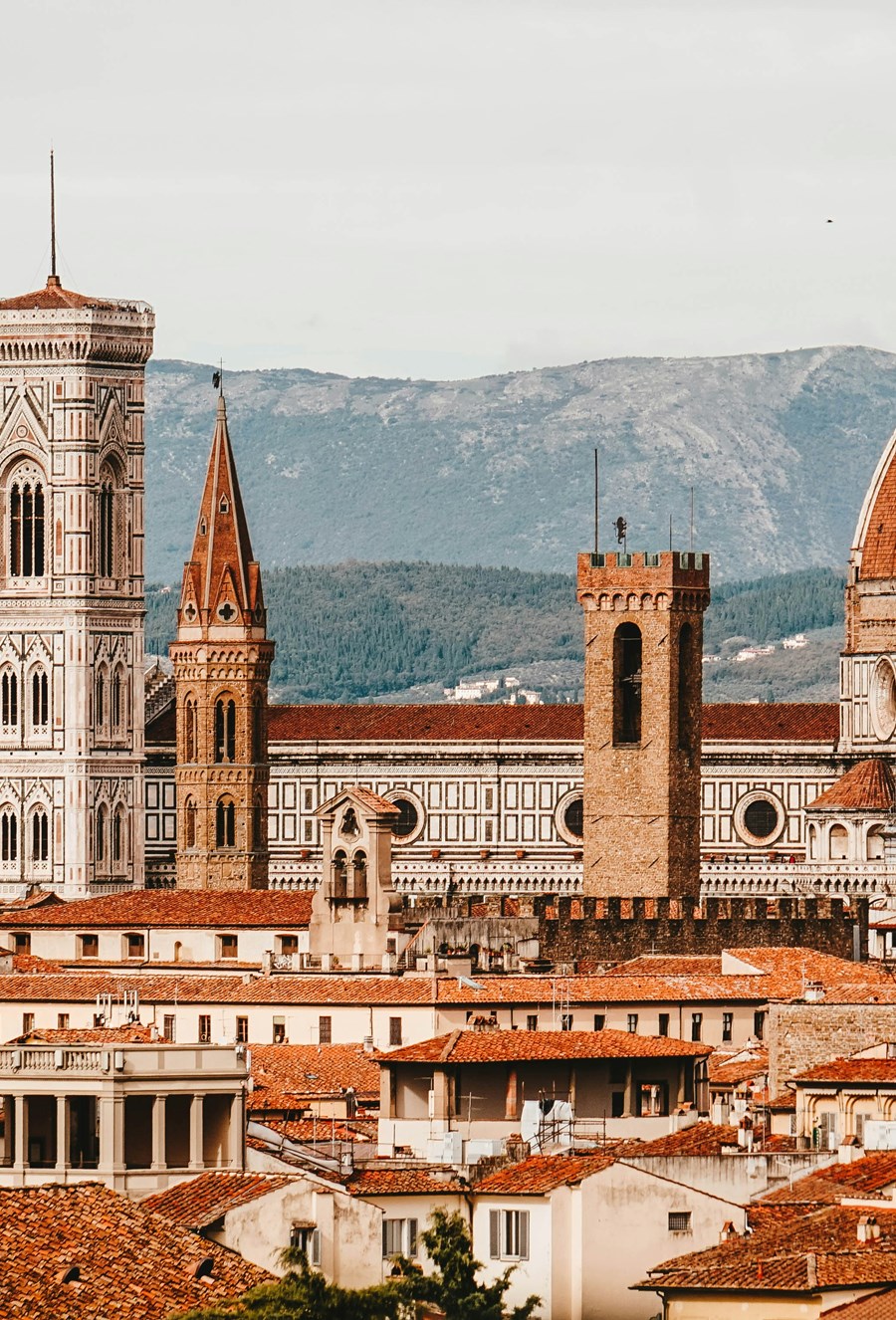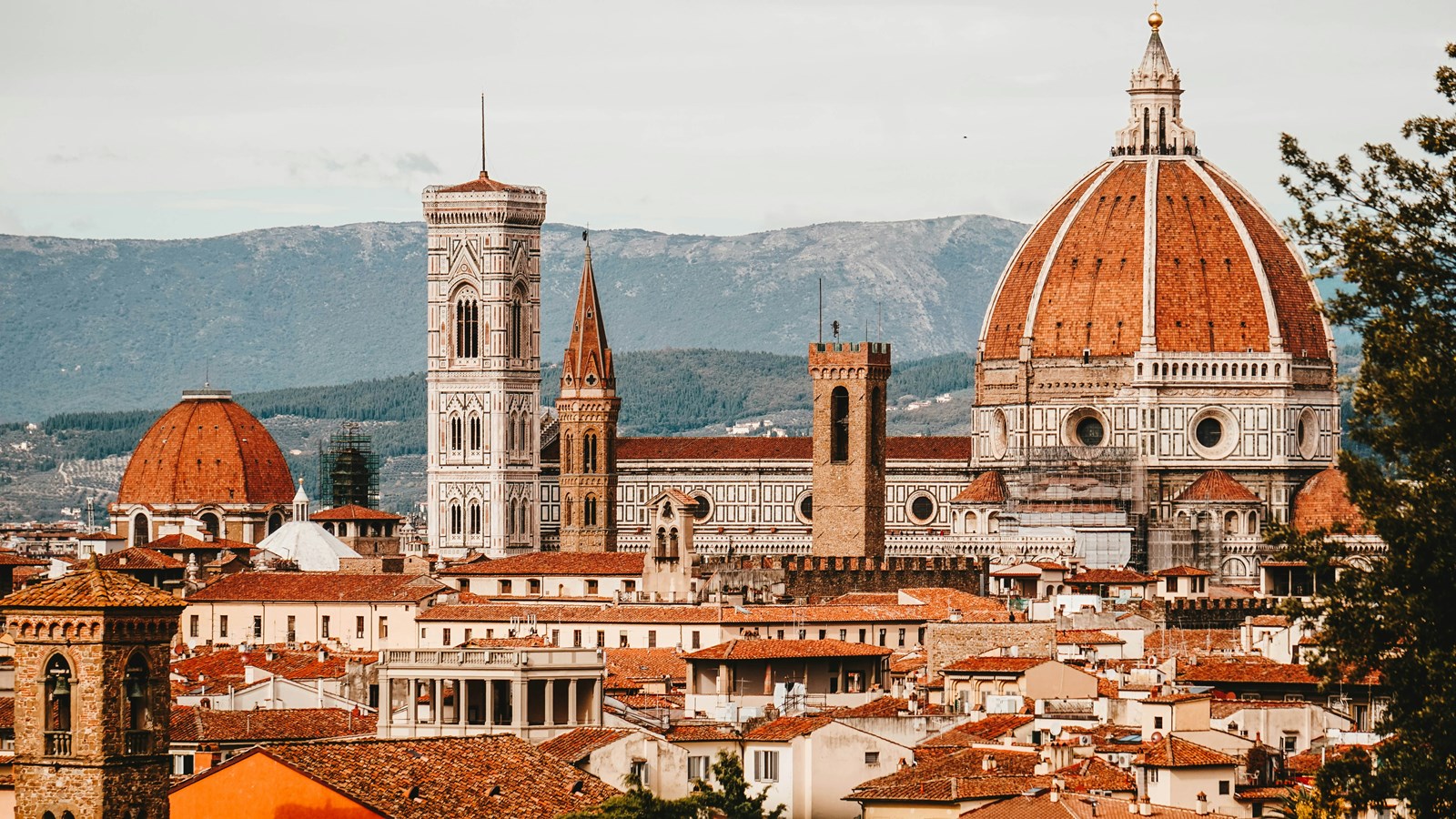Things to do in Florence
25 September 2025
Things to Do in Florence
If you’re planning to move to Florence while earning a degree, chances are you’ll find yourself surrounded by an overwhelming amount of things to do in Florence, Italy. Planning your adventure in the city starts with knowing what to expect when you arrive at your home in Florence.
We’ve rounded up over 10 top things to do in Florence to help you explore the city. From tourist attractions to renowned landmarks to mouthwatering restaurants, you’ll know Florence like the back of your hand by the time you’ve finished experiencing the city as a student.
Top Things to Do in Florence
Florence, Italy, is known for its remarkable landscape, historic buildings, quaint restaurants, and scenic shores. If you’re wondering what to see in Florence, below are some of the top places to visit in Florence:
- Florence Duomo
- Uffizi Gallery and Palazzo Vecchio
- Vasari Corridor
- Piazza della Signoria
- Galleria dell’Accademia
- Pitti Palace and Medici Heritage
- Boboli and Bardini Gardens
- Ponte Vecchio and the Arno
- Oltrarno District and Piazza Santo Spirito
- Historic Churches of Florence
- Piazzale Michelangelo
- San Miniato al Monte
Florence Attractions and Landmarks
Let’s break down all of the best things to do in Florence so that you can pick the attractions that fit your busy schedule as a student.

Duomo Complex Highlights
The Duomo Complex, also called Florence Duomo or the Cathedral of Santa Maria del Fiore, is a famous cathedral constructed throughout the 14th century and redesigned by Florence artists over the centuries. Once the largest cathedrals in all of Europe, the sheer grandeur of the cathedral is certain to leave a lasting impression.
Brunelleschi’s Dome Climb
For those looking for a workout on top of an adventure, Brunelleschi's Dome climb won't disappoint. Built during the 15th century, the structure is the largest masonry vault worldwide and stands tall as a beacon that showcases the architectural skills of Florence's architects and designers. There are no lifts to reach the top of the dome, so brace yourself as you walk over 450 steps to reach a view that overlooks the entire city.
Giotto’s Campanile Climb
Within the Duomo complex, you’ll find an Italian Gothic-style bell tower called Giotto’s Bell Tower. This Florence landmark peers over an impressive 84.7 meters, which you can climb if you’re prepared for over 400 steps.
Baptistery of San Giovanni
At the very front of the cathedral is the Baptistry of St John. The Italian Romanesque architecture of the monument located in front of the baptistery was consecrated in 1059. The baptistery is octagonal, decorated with intricate mosaics in the 13th and 14th centuries, and represents the rich religious history of Florence.
Museo dell’Opera del Duomo
More than 6,000 square meters in size, Museo dell’Opera del Duomo consists of 28 rooms spanning three levels. It’s adorned with famous artwork, avant-garde architecture, and technological equipment. When you step inside, you’ll find original work from Michelangelo, Donatello, and other famous artists. Just be sure to avoid going on the first Tuesday of each month, as the museum closes for maintenance work.
Crypt of Santa Reparata, Florence
Also called the ancient basilica of Santa Reparata, this basilica is located down a stairway within the cathedral. History and architecture fanatics will especially enjoy learning about the construction of the basilica, which stood for over 800 years before being demolished in 1379. The site is now nested underground within the new church, where it stores remnants of renovations, burials, tombstones, and mosaic floors.
Uffizi Gallery and Palazzo Vecchio
The Uffizi Gallery and Palazzo Vecchio are staples for every adventurous wanderer in Florence. The gallery holds some of the finest art and was once the Medici family’s administrative office, while Palazzo Vecchio housed the republic’s government organisations and continues to serve as offices.

Vasari Corridor
Built in the mid-1500s, the Vasari Corridor was designed to allow the Grand Duke passage between the Pitti Palace, where he resided, and his place of work (the Uffizi). Nearly a kilometre long, the covered walkway has more than 1,000 paintings and round viewing windows for tourists who book an appointment. Vasari Corridor tickets are typically purchased with tickets to the Uffizi Gallery.
Piazza della Signoria
Sat right in front of the Palazzo Vecchio lies an L-shaped building called the Piazza della Signoria. This square holds various sculptures depicting key historical events as well as mythological characters. The Piazza della Signoria is a free, open-air sculpture piazza, perfect for students.
Galleria dell’Accademia
If you're a fan of Michelangelo, then you must stop at the Galleria dell’Accademia. This gallery has the largest collection of sculptures by Michelangelo. You’ll also find paintings ranging from the medieval gold-ground art to the 19th century, sculptures from Giambologna and the Gipsoteca, musical instruments from the 17th to 19th centuries, and archives.
Pitti Palace and Medici Heritage
Pitti Palace is Florence's largest palace and served as a space for ceremonial residence. The Medici, the Habsburg-Lorraine, and the Savoy dynasties lived in the palace, and it was extended to make room for its infamous gardens in the mid-1500s. The palace currently houses several noteworthy museums in Florence, including the Palatine Gallery, Royal Apartments, the Treasure of the Grand Dukes, the Gallery of Modern Art, and the Museum of Costume and Fashion.
Boboli Gardens
Right behind the palace are the Boboli Gardens. Designed under the Medici family, the gardens offer a classic Italian-style finesse, with grottos, fountains, and open green spaces.
Bardini Gardens
Only a short distance away is a smaller, more intimate addition to the palace called the Bardini Gardens. There’s a cafè at the top of the gardens and a view of the city, making for a charming attraction full of fruit orchards, flowers, and tailored landscapes.
Ponte Vecchio and the Arno
Built in 966 and reconstructed after a flood in the 14th century, the Ponte Vecchio is a bridge that crosses the narrowest section of the river Arno. It’s free, open to the public 24/7, and a standing representation of skilled architectural work in Florence for its ability to withstand further flooding and the destruction from World War II.
Oltrarno District and Piazza Santo Spirito
The Oltrarno District is historically and currently home to Florence’s crafts, with workshops from professional artisans ranging from blacksmiths to leatherworkers. Dotted with markets for shopping in the daytime and buzzing with nightlife, the Oltrarno District is home to the Piazza Santo Spirito. This square is perfect for photographers looking to capture the heart of Florence on social media and beyond. You can find artisan shops, nightclubs, and fine dining, making it the perfect spot for souvenirs and keepsakes.

Historic Churches of Florence
Florence was divided into quartieri or quarters in the 1300s, with each quarter named after the most prominent church in the area. Brag to your friends about your expertise on Florence churches by visiting all four.
Basilica di Santa Croce
Santa Croce contains nearly 4,000 artworks from the 13th century to the 20th century, many of which still remain in their original forms. Walking inside this prolific basilica, you’ll see an impressive high altar embellished with magnificent paintings, tombs of important figures from the Renaissance period, and memorials.
Basilica di Santa Maria Novella
With over a million visitors annually, you don't want to miss out on the opportunity to explore Santa Maria Novella. Within this basilica lies the Filippo Strozzi Chapel, containing frescoes painted by Filippino Lippi in the late 1400s through the early 1500s, Masaccio’s Holy Trinity, a stunning fresco by Tommaso Guidi, and the Tornabuoni Chapel (Maggiore Chapel), which is the largest chapel in the basilica made in honor of the Virgin Mary.
Basilica di San Lorenzo and the Medici Chapels
Within the Museum of the Cappelle Medicee is the Basilica of San Lorenzo, which contains the funeral chapels of the Medici family. Now serving as a national monument and museum, you can explore the Medici Crypt, the Grand Dukes' mausoleum, and the jaw-dropping chapel decorated with a frescoed dome painted by Pietro Benvenuti.
Basilica di Santo Spirito
Designed by Filippo Brunelleschi, the Basilica of Santo Spirito sits on the left side of the Arno River and holds artwork by famous Florentine artists like Michelangelo, Filippo Lippi, Alessandro Allori, and Michele di Ridolfo del Ghirlandaio. In this basilica, you’ll see an impressive array of architectural expertise that can only be experienced in person. The non-profit Amici di Santo Spirito provides free access to the basilica, but if you want to take a tour, it costs 2 euros.
Viewpoints and Sunset Spots
Florence sightseeing is a prime reason to visit the city, with its countless viewpoints and sunset getaways, including the Piazzale Michelangelo and the San Miniato al Monte. Here’s what you need to know about each before you arrive.
Piazzale Michelangelo
Piazzale Michelangelo is one of the most popular Florence tourist attractions, and for good reason. Designed by Giuseppe Poggi in 1869, the piazza showcases copies of Michelangelo’s works. Though the piazza doesn’t have as long a history as other sites, its location gives students an astonishing view of the city and a replica of Michelangelo’s statue of David. The destination is free and accessible 24/7.
San Miniato al Monte
This basilica sits on a hill that hosts the rumored relics of St. Miniatus, a martyr from the 3rd century. With marble floors, various constructions over the centuries, the crypt, and strategically placed mosaics, the church offers a Tuscan Romanesque architectural design and unique, camera-ready decorations. Explore the lovely landscaping, the chapels, the sacristy, and the monumental cemetery tucked away beneath the church for the full experience.

Florence Walking Tours
The city has an overwhelming number of attractions, making it a bit difficult to know where to begin when creating your Florence itinerary. You may wish to book a Florence walking tour instead of exploring on your own. These guided tours have professional local guides in Florence to help you visit the staple tourist attractions during your study abroad. While they may be pricier alternatives to independent travel, you can often skip lines and receive a more in-depth exploration.
Here are a few walking tours to consider:
- VIP after-hour tours of the Florence Duomo
- Florence Accademia Gallery tour
- Florence in a Day: Michelangelo’s David, Uffizi, and guided city walking tour
- Renaissance and Medici Tales with a guided storyteller
- Florence sunset food and wine tour
- Uffizi Gallery small group tour
- The dark side of Florence: mysteries and legends tour
Free Things to Do in Florence
Walking tours aren’t for everyone, especially if you’re a student on a tight budget. You need not worry about what to do in Florence, Italy, however, as there are many free things to see in Florence, including the following destinations:
- Basilica di Santo Spirito
- Loggia dei Lanzi
- Oltrarno District
- Piazza del Duomo
- Piazza della Signoria
- Piazzale Michelangelo
- Piazza Santo Spirito
- Ponte Vecchio
Day Trips From Florence
Studying in Italy puts the entire country in the palm of your hand, so why not explore cities that are only a day-trip away from Florence? Here are five Florence day trips to the top cities to explore in Italy:
- Arezzo: Known as the city of arts, Arezzo is the birthplace of several famous artists, including Piero della Francesca and Giorgio Vasari.
- Bologna: Foodies don’t want to miss the opportunity to taste some of the finest food in Italy. As a student, check out the oldest university in the world, the University of Bologna, while stopping at different restaurants.
- Chianti: It doesn’t get more Tuscan than Chianti. As the name suggests, the famous red wine called Chianti originated in the city, and it has expansive, rolling vineyards as a showcase for the classic Tuscan landscape.
- Milan: About a two-hour train ride or three-hour drive from Florence, Milan may be more than a day trip, but it’s definitely a major city that showcases the Italian dolce vita “sweet life.” There are many things to do in Milan, like seeing Leonardo da Vinci's "The Last Supper" firsthand and exploring cathedrals with outstanding architecture.
- Pisa: No study in Italy is complete without visiting the Leaning Tower of Pisa.
- Siena: This medieval Tuscan city has beautiful architecture, like the Siena Cathedral, and offers delicious cuisine and a lively culture worth experiencing.

What to Do on Weekends in Florence
Many churches and museums are closed on Sundays, making it important to plan your weekend in Florence ahead of time. Weekends can also be very crowded and busy depending on the time of year, so if you do plan to visit Florence’s popular tourist destinations, consider doing a Florence walking tour to skip the lines. Alternatively, weekends are the perfect opportunity to simply walk through the city and explore different shops and squares.
Street markets worth visiting on the weekends include the San Lorenzo market, the Santo Spirito market, the Florence leather market, the Sant'Ambrogio market, and the Mercato Centrale.
Where to Eat in Florence
Florence, Italy, is known for its cuisine. We've rounded up the best restaurants to visit in Florence while studying at uni here.
Hidden Gem Restaurants in Florence
From traditional cuisine to scenic views to charming cafès, knowing where to eat in Florence is key to having the best experience possible while studying in the city. Check out these hidden gem restaurants and visit them if you have the opportunity:
- Alla Vecchia Bettola: This high-end restaurant is small but mighty, with marble tables and wood furnishings.
- Antico Ristoro di Cambi: For a restaurant that features an impressive interior design, Antico Ristoro di Cambi is a restaurant with vaulted ceilings. It serves wine and cold dishes.
- Caffè Gilli: Located in Piazza della Repubblica, this cafè offers coffee and traditional desserts, including biscotti and tiramisu.
- Osteria Nuvoli: This restaurant is a Florence favourite, with decent prices and authentic Tuscan cuisine.
- Le Volpi e l'Uva: Calling all wine lovers. Le Volpi e l'Uva serves wine and aesthetically pleasing charcuterie and cheese boards fit for updating friends and family of your travels via social media.
- Rivoire: Located in Piazza della Signoria, this chocolate shop offers Italian coffee, pastries, and decadent chocolates.
- Trattoria Sergio Gozzi. This rustic Italian restaurant serves heartwarming lunches worth visiting.
- Trattoria Mario: For an affordable lunch, Trattoria Mario offers delicious meat dishes, soups, and regional wines.
Eating in Florence on a Budget
As a student, budgeting for eating in Florence may be one of your top priorities outside of studying. The best way to save money while eating in Florence is to shop at street food vendors or purchase fresh produce from markets and cook your own Tuscan dishes. Top street food vendors include Semel Street Food, Bondi, Panificio Brunori, Pugi, and SandwiChic.
Mercato Centrale and Mercato di San Lorenzo
If you've opted for purchasing fresh produce, then you must visit the Mercato Centrale and Mercato di San Lorenzo. Both destinations are located on two floors and feature tasty markets with fresh produce, affordable food, and wine. You get to taste samples from different vendors, creating a very hands-on experience that will leave your stomach satisfied.
Moving to Florence as a Student
Florence is a city steeped in rich history. From elaborate architectural innovations to statues and paintings from renowned artists, you’ll never want for things to do in Florence. Whether you’re looking for daytime adventures or want to explore the nightlife, the city has much to offer, making it a great place to go to university.
If you’re considering academia in Florence, the best thing you can do is create a safe home away from home. At Aparto, we offer Florence student accommodation in the heart of the city. Our student housing gives you quick access to museums, restaurants, campuses, and more in a welcoming student community. Book your student accommodation in Florence with Aparto today.



